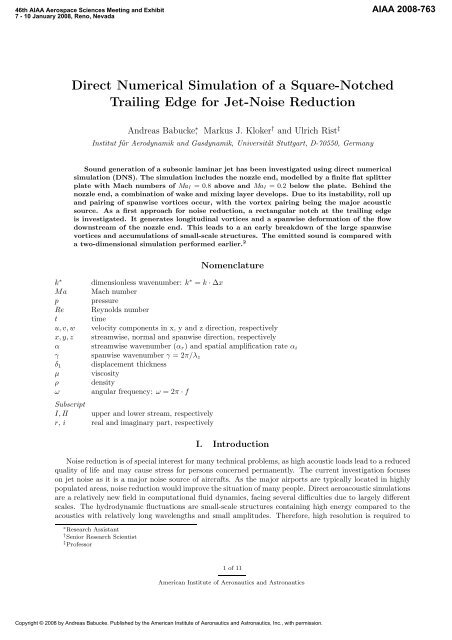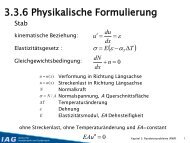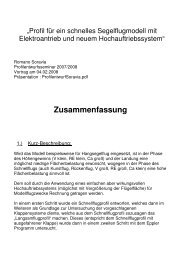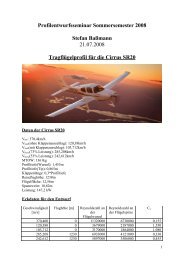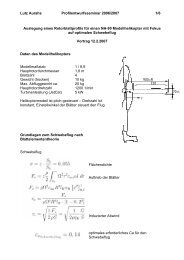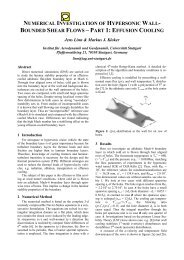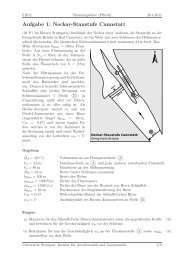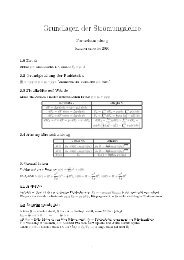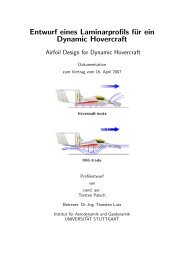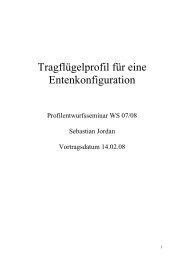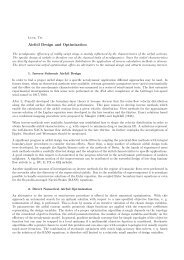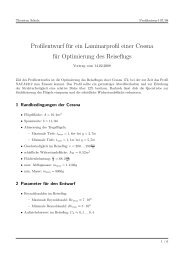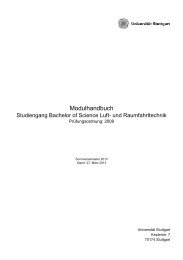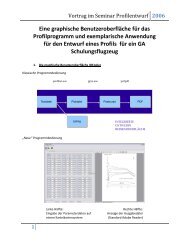pdf-File - IAG - Universität Stuttgart
pdf-File - IAG - Universität Stuttgart
pdf-File - IAG - Universität Stuttgart
Create successful ePaper yourself
Turn your PDF publications into a flip-book with our unique Google optimized e-Paper software.
46th AIAA Aerospace Sciences Meeting and Exhibit<br />
7 - 10 January 2008, Reno, Nevada<br />
AIAA 2008-763<br />
Direct Numerical Simulation of a Square-Notched<br />
Trailing Edge for Jet-Noise Reduction<br />
Andreas Babucke ∗ , Markus J. Kloker † and Ulrich Rist ‡<br />
Institut für Aerodynamik und Gasdynamik, Universität <strong>Stuttgart</strong>, D-70550, Germany<br />
Sound generation of a subsonic laminar jet has been investigated using direct numerical<br />
simulation (DNS). The simulation includes the nozzle end, modelled by a finite flat splitter<br />
plate with Mach numbers of Ma I = 0.8 above and Ma I = 0.2 below the plate. Behind the<br />
nozzle end, a combination of wake and mixing layer develops. Due to its instability, roll up<br />
and pairing of spanwise vortices occur, with the vortex pairing being the major acoustic<br />
source. As a first approach for noise reduction, a rectangular notch at the trailing edge<br />
is investigated. It generates longitudinal vortices and a spanwise deformation of the flow<br />
downstream of the nozzle end. This leads to a an early breakdown of the large spanwise<br />
vortices and accumulations of small-scale structures. The emitted sound is compared with<br />
a two-dimensional simulation performed earlier. 2<br />
k ∗<br />
Nomenclature<br />
dimensionless wavenumber: k ∗ = k · ∆x<br />
Ma Mach number<br />
p pressure<br />
Re Reynolds number<br />
t time<br />
u, v, w velocity components in x, y and z direction, respectively<br />
x, y, z streamwise, normal and spanwise direction, respectively<br />
α streamwise wavenumber (α r ) and spatial amplification rate α i<br />
γ spanwise wavenumber γ = 2π/λ z<br />
δ 1 displacement thickness<br />
µ viscosity<br />
ρ density<br />
ω angular frequency: ω = 2π · f<br />
Subscript<br />
I, II upper and lower stream, respectively<br />
r, i real and imaginary part, respectively<br />
I. Introduction<br />
Noise reduction is of special interest for many technical problems, as high acoustic loads lead to a reduced<br />
quality of life and may cause stress for persons concerned permanently. The current investigation focuses<br />
on jet noise as it is a major noise source of aircrafts. As the major airports are typically located in highly<br />
populated areas, noise reduction would improve the situation of many people. Direct aeroacoustic simulations<br />
are a relatively new field in computational fluid dynamics, facing several difficulties due to largely different<br />
scales. The hydrodynamic fluctuations are small-scale structures containing high energy compared to the<br />
acoustics with relatively long wavelengths and small amplitudes. Therefore, high resolution is required to<br />
∗ Research Assistant<br />
† Senior Research Scientist<br />
‡ Professor<br />
1 of 11<br />
American Institute of Aeronautics and Astronautics<br />
Copyright © 2008 by Andreas Babucke. Published by the American Institute of Aeronautics and Astronautics, Inc., with permission.
compute the noise sources accurately. On the other hand a large computational domain is necessary to<br />
obtain the relevant portions of the acoustic far-field. Due to the small amplitudes of the emitted noise,<br />
boundary conditions have to be chosen carefully, in order not to spoil the acoustic field with reflections.<br />
Up to now, large-eddy or direct numerical simulations of jet noise have been focusing on either pure<br />
mixing layers 1,4,7 or low Reynolds number jets, 8 where an S-shaped velocity profile is prescribed at the<br />
inflow. Our approach is to include the nozzle end, modelled by a thin finite flat plate with two different<br />
free-stream velocities above and below. Including the nozzle end shifts the problem to a more realistic<br />
configuration, leading to a combination of wake and mixing layer behind the splitter plate. Additionally,<br />
wall-bounded actuators for noise reduction can be tested without the constraint to model them by artifical<br />
volume forces. In the current investigation, a passive ’actuator’ is considered as a first realistic approach for<br />
noise reduction.<br />
II.A.<br />
DNS code<br />
II. Numerical Method<br />
The simulation is carried out using the DNS code NS3D. 3 It solves the three-dimensional unsteady compressible<br />
Navier-Stokes equations on multiple domains. The purpose of domain decomposition is not only<br />
to increase computational performance, the combination with grid transformation and modular boundary<br />
conditions allows to compute a wider range of problems. Computation is done in non-dimensional quantities:<br />
velocities are normalized by the reference velocity U ∞ and all other quantities by their freestream values,<br />
marked with the subscript ∞. Length scales are made dimensionless with a reference length L and the<br />
time t with L/U ∞ , where the overbar denotes dimensional values. Temperature dependence of viscosity µ<br />
is modelled using the Sutherland law:<br />
µ(T) = µ(T ∞ ) · T 3/2 · 1 + T s<br />
T + T s<br />
, (1)<br />
where T s = 110.4K/T ∞ and µ(T ∞ = 280K) = 1.735 · 10 −5 kg/(ms). Thermal conductivity ϑ is obtained by<br />
assuming a constant Prandtl number Pr = c p µ/ϑ = 0.71 and a constant heat capacity c p . The most characteristic<br />
parameters describing a compressible viscous flow-field are the Reynolds number Re = ρ ∞ U ∞ L/µ ∞<br />
and the Mach number Ma = U ∞ /c ∞ with c being the speed of sound.<br />
We use the conservative formulation of the Navier-Stokes equations which results in the solution vector<br />
Q = [ρ, ρu, ρv, ρw, E] containing the density, the three momentum densities, and the total energy per volume<br />
E = ρ · c v · T + ρ 2 · (u 2 + v 2 + w 2) . The simulation is carried out in a rectangular domain with x, y, z being<br />
the coordinates in streamwise, normal and spanwise direction, respectively. A typical setup for jet-noise<br />
computations is shown in figure 1.<br />
y<br />
z<br />
x<br />
0000000000000000<br />
1111111111111111<br />
0000000000000000<br />
1111111111111111<br />
0000000000000000<br />
1111111111111111<br />
0000000000000000<br />
1111111111111111<br />
0000000000000000<br />
1111111111111111<br />
0000000000000000<br />
1111111111111111<br />
0000000000000000<br />
1111111111111111<br />
0000000000000000<br />
1111111111111111<br />
0000000000000000<br />
1111111111111111<br />
0000000000000000<br />
1111111111111111<br />
0000000000000000<br />
1111111111111111<br />
0000000000000000<br />
1111111111111111<br />
0000000000000000<br />
1111111111111111<br />
0000000000000000<br />
1111111111111111<br />
0000000000000000<br />
1111111111111111<br />
0000000000000000<br />
1111111111111111<br />
0000000000000000<br />
1111111111111111<br />
0000000000000000<br />
1111111111111111<br />
0000000000000000<br />
1111111111111111<br />
0000000000000000<br />
1111111111111111<br />
0000000000000000<br />
1111111111111111<br />
λ z,0<br />
Figure 1. Integration domain for jet noise computation with splitter plate and sponge zone.<br />
Since the flow is assumed to be periodic in spanwise direction a spectral Fourier discretization in z<br />
direction is used. The fundamental spanwise wavenumber γ 0 is given by the fundamental wavelength λ z,0<br />
2 of 11<br />
American Institute of Aeronautics and Astronautics
epresenting the spanwise width of the integration domain by γ 0 = 2π/λ z,0 . Spanwise derivatives are<br />
computed by transforming the respective variable into Fourier space, multiplying its spectral components<br />
with their wavenumbers (i · k · γ 0 ) for the first derivatives or square of their wavenumbers for the second<br />
derivatives and transforming them back into physical space. Due to the non-linear terms in the Navier-Stokes<br />
equations, higher harmonic spectral modes are generated at each timestep. To suppress aliasing, only 2/3 of<br />
the maximum number of modes for a specific z resolution are used. 5 If a two-dimensional baseflow is used<br />
and disturbances of u, v, ρ, T, p are symmetric and disturbances of w are antisymmetric, flow variables<br />
are symmetric/antisymmetric with respect to z = 0. Therefore only half the number of points in spanwise<br />
direction are needed (0 ≤ z ≤ λ z /2).<br />
The spatial discretization in streamwise (x) and normal (y) direction is done by 6 th -order compact finite<br />
differences. The tridiagonal equation systems of the compact finite differences are solved along multiple<br />
domains using the pipelined Thomas algorithm. 3 To reduce the aliasing error, alternating up- and downwindbiased<br />
finite differences are used for convective terms as proposed by Kloker. 10 The second derivatives are<br />
evaluated directly which distinctly better resolves viscous terms compared to applying the first derivative<br />
twice. 1 The time integration of the solution vector Q is done using the classical 4 th -order Runge-Kutta<br />
scheme. 10 At each timestep and each intermediate level, the biasing of the finite differences for the convective<br />
terms is changed. Mapping the physical x-y grid on an equidistant computational ξ-η grid allows arbitrary<br />
grid transformations in the x-y plane.<br />
II.B. Boundary conditions<br />
For the jet-noise investigation, we use a one-dimensional characteristic boundary condition 9 at the freestream.<br />
This allows outward-propagating acoustic waves to leave the domain. An additional damping zone forces<br />
the flow variables smoothly to a steady state solution, avoiding reflections due to oblique waves. Having a<br />
subsonic flow, we also use a characteristic boundary condition at the inflow, allowing upstream propagating<br />
acoustic waves to leave the domain. Additionally amplitude and phase distributions from linear stability<br />
theory can be prescribed to introduce defined disturbances. The outflow is the most crucial part as one<br />
has to avoid high-amplitude structures passing the boundary and contaminating the sensitive acoustic field.<br />
Therefore, a combination of grid stretching and spatial low-pass filtering along the x-direction is applied in<br />
the sponge region. Disturbances become increasingly badly resolved as they propagate through the sponge<br />
region. As the spatial filter depends on the step size in x-direction, perturbations are smoothly dissipated<br />
before they reach the outflow boundary. This procedure shows very low reflections and has been already<br />
applied by Colonius et al. 6<br />
For the splitter plate representing the nozzle end, an isothermal boundary condition is used with the wall<br />
temperature fixed at the value of the initial condition. The pressure is obtained by extrapolation from the<br />
interior gridpoints. An extension of the wall boundary condition is the modified trailing edge, where the end<br />
of the splitter plate is no more constant along the spanwise direction. As we have grid transformation only in<br />
the x-y plane and not in z-direction, the spanwise dependency of the trailing edge is achieved by modifying<br />
the connectivity of the affected domains. Instead of regularly prescribing the wall boundary condition along<br />
the whole border of the respective subdomain, we can also define a region without wall. At these gridpoints,<br />
the spatial derivatives in normal direction are recomputed, now using also values from the domain at the<br />
other side of the splitter plate. The spanwise derivatives are computed in the same manner as inside the<br />
flowfield with the Fourier-transformation being applied along the whole spanwise extent of the domain. The<br />
modular boundary conditions, chosen because of flexibility, require explicit boundary conditions and by that<br />
a non-compact finite-difference scheme, locally. Therefore explicit finite differences have been developed with<br />
properties quite similar to the compact scheme used in the rest of the domain. According to Lele, 11 the<br />
examination of the finite differences is based on the modified wavenumber kmod ∗ and its square k∗2<br />
mod<br />
for the<br />
first and the second derivative, respectively. The numerical properties of the chosen 8 th -order scheme are<br />
compared with standard explicit 6 th -order finite differences and the compact scheme of 6 th order, regularly<br />
used in the flowfield. For the first derivative, the real and imaginary parts of the modified wavenumber kmod<br />
∗<br />
are shown in figure 2: the increase from order six to eight does not fully reach the good dispersion relation<br />
of the 6 th -order compact scheme but at least increases the maximum of kmod ∗ by 10% compared with an<br />
ad hoc explicit 6 th -order implementation. The imaginary part of the modified wavenumber, responsible for<br />
dissipation, shows similar characteristics as the compact scheme with the same maximum as for the rest of<br />
the domain. For the second derivative, shown by the square of the modified wavenumber kmod ∗2 in figure 3,<br />
the increase of its order improves the properties of the explicit finite difference towards the compact scheme.<br />
3 of 11<br />
American Institute of Aeronautics and Astronautics
3<br />
exact<br />
Re(k* mod<br />
) FD-O8<br />
Re(k* mod<br />
) CFD-O6<br />
Re(k* mod<br />
) FD-O6<br />
Im(k* mod<br />
) FD-O8<br />
Im(k* mod<br />
) CFD-O6<br />
8<br />
exact<br />
Re(k* 2 mod<br />
) FD O8<br />
Re(k* 2 mod<br />
) CFD O6<br />
Re(k* 2 ) FD O6<br />
mod<br />
k* mod<br />
2<br />
k* 2 mod<br />
6<br />
4<br />
1<br />
2<br />
0<br />
0 0.5 1 1.5 2 2.5 3<br />
k*<br />
Figure 2. Real and imaginary part of the<br />
modified wavenumber k ∗ mod for the first<br />
derivative based on a wave with wave number<br />
k ∗ = k · ∆x. Comparison of 8 th -order<br />
explicit finite difference with 6 th -order explicit<br />
and compact scheme.<br />
0<br />
0 0.5 1 1.5 2 2.5 3<br />
k*<br />
Figure 3. Square of the modified wavenumber<br />
of the second derivative for a wave with<br />
wave number k ∗ = k · ∆x. Comparison of<br />
8 th -order explicit finite difference with 6 th -<br />
order explicit and compact scheme.<br />
II.C.<br />
Initial condition<br />
For the current investigation, an isothermal laminar subsonic jet with the Mach numbers Ma I = 0.8 for the<br />
upper and Ma II = 0.2 for the lower stream has been selected. As both temperatures are equal (T 1 = T 2 =<br />
280K), the ratio of the streamwise velocities is U I /U II = 4. This large factor leads to strong instabilities<br />
behind the nozzle end. The Reynolds number Re = ρ ∞ U 1 δ 1,I /µ ∞ = 1000 is based on the displacement<br />
thickness δ 1,I of the upper stream at the inflow. With δ 1,I (x 0 ) = 1, length scales are normalized with the<br />
displacement thickness of the fast stream at the inflow. The boundary layer of the lower stream corresponds<br />
to the same origin of the flat plate.<br />
The cartesian grid is decomposed into sixteen subdomains: eight in streamwise and two in normal<br />
direction. Each subdomain contains 325 x 425 x 65 points in x-, y- and z-direction, resulting in 42 spanwise<br />
modes (dealiased) and a total number of 143.6 million gridpoints. The mesh is uniform in streamwise<br />
direction with a step size of ∆x = 0.15 up to the sponge region, where the grid is highly stretched. In normal<br />
direction, the finest step size is ∆y = 0.15 in the middle of the domain with a continuous stretching up to a<br />
spacing of ∆y = 1.06 at the upper and lower boundaries. In spanwise direction, the grid is uniform with a<br />
spacing of ∆z = 0.2454 which is equivalent to a spanwise wavenumber γ 0 = 0.2, where λ z /2 = π/γ 0 = 15.708<br />
is the spanwise extent of the domain. The origin of the coordinate system (x = 0, y = 0) is located at the<br />
end of the nozzle. Figure 4 shows the x-y plane of the integration domain, illustrating the grid stretching<br />
and the domain decomposition. The nozzle end itself is modeled by a finite thin flat plate with a thickness<br />
of one ∆y. Due to the vanishing thickness of the nozzle end, an isothermal boundary condition at the wall<br />
has been chosen. The temperature of the plate is T wall = 296K, being the mean value of the adiabatic wall<br />
temperatures of the two streams.<br />
The initial condition along the flat plate is obtained from similarity solutions of the boundary-layer<br />
equations. Further downstream, the compressible boundary-layer equations are integrated downstream,<br />
providing a flow-field sufficient to serve as an initial condition and for linear stability theory. Due to the<br />
geometrical discontinuity at the trailing edge, an ad-hoc solution of the boundary-layer equations shows a<br />
peak in the wall-normal velocity v. Therefore, its value is smoothed around x = 0, providing a more realistic<br />
flow field. Thus the characteristic boundary condition at the freestream can be linearized with respect to<br />
the initial condition. The resulting streamwise velocity profiles of the initial condition are shown in figures 5<br />
and 6. Behind the nozzle end, the flow field keeps its wake-like shape for a long range. As high amplification<br />
rates occur here, the flow is already unsteady before a pure mixing layer has developed. This means that<br />
the pure mixing layer investigated earlier 1,4,7 has to be considered as a rather theoretical approach.<br />
4 of 11<br />
American Institute of Aeronautics and Astronautics
0.4<br />
0.2<br />
y<br />
0<br />
100<br />
-0.2<br />
-0.4<br />
-0.6<br />
x<br />
-0.5 0 0.5<br />
y<br />
0<br />
-100<br />
0 100 200 300<br />
x<br />
Figure 4. Integration domain in the x-y plane showing every 25 th grid line. The colour indicates the domain decomposition.<br />
III. Linear Stability Theory<br />
Spatial linear stability theory (LST) 12 is based on the linearization of the Navier-Stokes equations, split<br />
into a steady two-dimensional baseflow and wavelike disturbances<br />
Φ = ˆΦ (y) · e i(αx+γz−ωt) + c.c. (2)<br />
with Φ = (u ′ , v ′ , w ′ , ρ ′ , T ′ , p ′ ) representing the set of fluctuations of the primitive variables. As only first<br />
derivatives in time occur, the temporal problem, where the streamwise wavenumber α = α r is prescribed,<br />
is solved first by a 4 th -order matrix solver providing the complex eigenvalues (ω r , ω i ), with ω r being the<br />
frequency and ω i the temporal amplification. Once an amplified eigenvalue is found, the Wielandt iteration<br />
iterates the temporal to the spatial problem by varying the spatial amplification −(α i ) such that ω i = 0. This<br />
can also be done for a range of streamwise wavenumbers α r and x positions to obtain a stability diagram. A<br />
selected spatial eigenvalue (α r , α i ) can be fed into the matrix solver to obatin the eigenfunction, being the<br />
amplitude and phase distribution of the primitive variables along y. The eigenfunctions can be used directly<br />
in the DNS-code for disturbance generation at the inflow.<br />
As the flow is highly unsteady behind the nozzle end and enforcing an artificial steady state does not<br />
work properly, we use the initial condition derived from the boundary-layer equations to compute eigenvalues<br />
and eigenfunctions. According to figure 7, a fundamental angular frequency of ω 0 = 0.0688 was chosen for<br />
the upper boundary layer. The amplification keeps almost constant in downstream direction. As the two<br />
boundary layers emerge from the same position, the lower boundary layer is stable up to the nozzle end.<br />
Behind the edge of the splitter plate, amplification rates 50 times higher than in the upper boundary layer<br />
5 of 11<br />
American Institute of Aeronautics and Astronautics
occur due to the inflection points of the streamwise-velocity profile. Maximum amplification in the mixing<br />
layer takes place for a frequency of roughly three to four times of the fundamental frequency of the boundary<br />
layer as illustrated in figure 8.<br />
15<br />
15<br />
y<br />
10<br />
5<br />
0<br />
x = -97.5<br />
Reδ 1<br />
= 1000<br />
y<br />
10<br />
5<br />
0<br />
x = 0 ... 96.75<br />
-5<br />
-5<br />
-10<br />
-10<br />
-15<br />
0 0.2 0.4 0.6 0.8 1<br />
u<br />
Figure 5. Profile of the streamwise velocity u<br />
for the upper and lower boundary layer at the<br />
inflow.<br />
-15<br />
0 0.2 0.4 0.6 0.8 1<br />
u<br />
Figure 6. Downstream evolution of the streamwise<br />
velocity profile behind the nozzle end.<br />
-0.01<br />
0<br />
-0.2<br />
-0.1<br />
ω 0<br />
= 0.0688<br />
x = 1.35<br />
x = 13.35<br />
α i<br />
0.01<br />
ω 0<br />
= 0.0688<br />
x = -0.15<br />
x = -97.5<br />
α i<br />
0<br />
0.1<br />
0.05<br />
ω<br />
0.1 0.15<br />
r<br />
0.2<br />
0.1<br />
ω<br />
0.2 0.3<br />
r<br />
Figure 7. Amplification rates of the upper<br />
(fast) boundary layer given by linear stability<br />
theory for various x−positions.<br />
Figure 8. Amplification rates for various<br />
x−positions behind the splitter plate predicted<br />
by linear stability theory.<br />
IV. DNS Results<br />
For the pure mixing layer without splitter plate, 1 we already found that introducing a steady longitudinal<br />
vortex leads to a break-up of the large spanwise vortices and may reduce the emitted sound originating from<br />
vortex pairing. A variety of wall-mounted actuators are conceivable for the generation of streamwise vortices:<br />
Our approach is to engrail the trailing edge of the splitter plate. Here, a rectangular spanwise profile of one<br />
notch per spanwise wavelength with a depth of 10 in x-direction has been chosen. At the inflow of the upper<br />
boundary layer, the flow is disturbed with the Tollmien-Schlichting (TS) wave (1, 0) with the fundamental<br />
frequency ω 0 and an amplitude of û max = 0.005, being the same as for the two-dimensional simulation,<br />
performed earlier. 2 The TS wave generates higher harmonics in the upper boundary layer, driving the rollup<br />
of spanwise vortices (Kelvin-Helmholtz instability) and the subsequent vortex pairing behind the splitter<br />
plate. An additional oblique wave (1, 1) with a small amplitude of û max = 0.0005 is intended to provide a<br />
more realistic inflow disturbance than a purely two-dimensional forcing. A total number of 80000 timesteps<br />
with ∆t = 0.018265 has been computed, corresponding to an non-dimensional elapsed time of t = 1461, with<br />
the last four periods of the fundamental frequency used for analysis.<br />
6 of 11<br />
American Institute of Aeronautics and Astronautics
IV.A.<br />
Flow Field<br />
The instantaneous flowfield is illustrated in figure 9, showing the λ 2 vortex criterion. Small vortices emerge<br />
from the longitudinal edges, slightly deforming the first spanwise vortex of the Kelvin-Helmholtz instability.<br />
Further downstream, multiple streamwise vortices exist per λ z,0 , being twisted around the spanwise vortices.<br />
This vortex interaction leads to a breakdown of the large spanwise vortices. From x ≈ 120 onwards, the<br />
Kelvin-Helmholtz vortices known from two-dimensional investigations are now an accumulation of smallscale<br />
structures. The spanwise vorticity at z = 0 for the serrated nozzle end and for the corresponding<br />
two-dimensional simulation 2 is shown in figure 10. The initial roll up of the mixing layer is quite similar.<br />
These generated Kelvin-Helmholtz vortices merge further downstream for the two-dimensional case. With<br />
the rectangularly serrated trailing edge, the disintegration of the spanwise vortices begins at x ≈ 90 resulting<br />
in a breakdown into smaller structures further downstream (x > 120).<br />
Figure 9. Perspective view of the engrailed trailing edge and the vortical structures in the instantaneous flow field,<br />
visualized by the isosurface λ 2 = −0.005. The distance from the plane of the splitter plate (y = 0) is colored from blue<br />
(y < 0) to red (y > 0).<br />
A spectral decomposition is shown in figures 11 and 12, based on the maximum of v along y. The normal<br />
velocity has been chosen as it is less associated with upstream propagating sound. The modes are denoted<br />
as (h, k) with h and k being the multiple of the fundamental frequency ω 0 and the spanwise wavenumber γ 0 ,<br />
respectively. As figure 11 shows, the nonlinear interaction of the introduced disturbances (1, 0) and (1, 1) in<br />
the upper boundary layer generates nonlinearly the mode (0, 1) up to an amplitude of ˆv = 2 · 10 −5 . From<br />
x = −25 onwards, the upstream effect of the notch at the end of the splitter plate prevails. The engrailment<br />
at the end of the splitter plate (−10 ≤ x ≤ 0) generates steady three-dimensional disturbances (0, k) with<br />
peaks up to ˆv = 8 · 10 −3 at the corners. In the notch (7.8 ≤ z ≤ 23.6), the combination of wake and mixing<br />
layer originates further upstream at x = −10 instead of x = 0. This results in a spanwise deformation,<br />
corresponding to the disturbance (0, 1). Its amplitude decreases behind the splitter plate up to x = 15.<br />
Higher harmonics in spanwise direction (0, 2) and (0, 4) are generated at the notch as well, but only mode<br />
(0, 2) shows a similar upstream effect as mode (0, 1). Behind the splitter plate, the amplitudes of the first two<br />
higher harmonics in spanwise direction stay almost constant at an amplitude of ˆv ≈ 6 ·10 −4 and ˆv ≈ 4 ·10 −4 ,<br />
respectively. As two streamwise vortices per λ z,0 emerge from the longitudinal edges, the steady, spanwise<br />
higher harmonics mainly correspond to these streamwise vortices. The similar amplitudes behind the splitter<br />
plate indicate that the engrailed trailing edge introduces a spanwise deformation due to the different origin<br />
of the mixing layer as well as longitudinal vortices. For x > 40, all steady modes grow due to non-linear<br />
interaction with the traveling waves, resulting in a spanwise deformation of the mixing layer.<br />
7 of 11<br />
American Institute of Aeronautics and Astronautics
Figure 10. Comparison of the spanwise vorticity for the two-dimensional case (top) and the serrated nozzle end (below)<br />
at spanwise position z = 0.<br />
The introduced two-dimensional TS wave grows slowly in the upper boundary layer. Figure 13 reveals<br />
the good agreement of its amplification rate with linear stability theory. Near the end of the splitter plate,<br />
the amplification rate differs from LST due to the discontinuity in geometry. With an amplitude of the<br />
driving TS wave of ˆv ≈ 2 · 10 −3 , shown in figure 12, the generated higher harmonic modes (2, 0), (3, 0) reach<br />
an amplitude of ˆv ≈ 3 · 10 −4 and ˆv ≈ 2 · 10 −5 , respectively. According to the forcing at the inflow, only<br />
low-amplitude oblique disturbances (2, 1) and (3, 1) are generated in the upper boundary layer. Behind the<br />
splitter plate, the growth of two-dimensional disturbances (h, 0) is only weakly affected by the engrailed<br />
trailing edge. The growth rate of the fundamental frequency shows excellent agreement with linear stability<br />
theory. The higher the frequency of the disturbances, the more differs their amplification rate with a slightly<br />
lower mean amplification value compared to LST. The initially small three-dimensional disturbances (h, 1)<br />
grow instantaneously at the beginning of the notch (x = −10) by approximately one order of magnitude.<br />
Further downstream, they are driven by their two-dimensional counterparts (h, 0). Saturation of the first<br />
two higher harmonics (2, 0) and (3, 0) occurs at x ≈ 70, the position of the first vortex roll up. The twodimensional<br />
fundamental disturbance (1, 0) saturates at x ≈ 140. This corresponds to the pairing of the<br />
accumulated smaller-scale structures.<br />
10 -2<br />
10 -2<br />
10 -3<br />
v’<br />
10 -1 (0,1)<br />
10 -3<br />
v’<br />
10 -1 (1,0)<br />
10 -4<br />
10 -5<br />
10 -6<br />
-50 0 50 100<br />
x<br />
(0,2)<br />
(0,4)<br />
(0,8)<br />
10 -4<br />
10 -5<br />
10 -6<br />
0 100 200<br />
x<br />
(1,1)<br />
(2,0)<br />
(2,1)<br />
(3,0)<br />
(3,1)<br />
Figure 11. Generation of the steady modes<br />
(0, k) at the trailing edge, based on the maximum<br />
of v over y.<br />
Figure 12. Maximum amplitude of normal velocity<br />
v along y for unsteady modes (h, k).<br />
8 of 11<br />
American Institute of Aeronautics and Astronautics
-0.03<br />
-0.02<br />
-0.01<br />
α i<br />
0<br />
0.01<br />
0.02<br />
(1,0)<br />
-80 -60 -40 -20 0<br />
x<br />
-0.4<br />
-0.3<br />
-0.2<br />
-0.1<br />
α i<br />
0<br />
0.1<br />
0.2<br />
0 10 20 30<br />
x<br />
(1,0)<br />
(2,0)<br />
(3,0)<br />
Figure 13. Amplification rate of the Tollmien-<br />
Schlichting wave, compared with linear stability<br />
theory (marked with symbols).<br />
Figure 14. Amplification rates of twodimensional<br />
disturbances behind the splitter<br />
plate, compared with linear stability theory<br />
(marked with symbols).<br />
IV.B.<br />
Acoustic Field<br />
In order to evaluate the effect of the modified trailing edge, the emitted sound is compared with a twodimensional<br />
simulation with the same flow parameters, performed earlier. 2 The acoustic field, visualized by<br />
the dilatation ∇⃗u, is given for the two cases in figures 15 and 16 for the two-dimensional simulation and the<br />
engrailed trailing edge, respectively. In both cases, no reflections from the boundaries are visible. For the<br />
two dimensional simulation, the acoustic field is determined by long-wave sound, originating mainly from<br />
x ≈ 150 and x ≈ 220. This corresponds to the positions of vortex pairing. 2 The emitted sound for the<br />
engrailed trailing edge is mainly high-frequency noise with short wavelengths.<br />
Despite being a two-dimensional simulation, the acoustic field in figure 15 is less clear than for the pure<br />
mixing layer. 7 Nevertheless two main sources can be determined at x ≈ 150 and x ≈ 220, corresponding<br />
to the positions of vortex pairing. 2 The emitted sound for the engrailed trailing edge is mainly highfrequency<br />
noise with short wavelengths as shown in figure 16. The main sources are located at x ≈ 140 and<br />
x ≈ 200 which is equivalent to the pairing of the allocations of the small-scale structures. For both, the<br />
two-dimensional case and the modified trailing edge, sound generation takes place not directly at the edge<br />
of the splitter plate but further downstream in the mixing layer.<br />
The dilatation plots themselves do not show clearly whether the emitted sound is reduced. By placing<br />
an observer in the acoustic far-field (x = 195, y = −121.8, z = 0), marked by a red cross in figure 16, the<br />
sound pressure level can be evaluated more precisely. The time-dependent pressure fluctuations are shown in<br />
figure 17 over four periods of the fundamental frequency. For both cases, the pressure fluctuations are almost<br />
random. The two-dimensional sample is dominated by low-frequency fluctuations compared to the engrailedtrailing-edge<br />
case. The pressure fluctuations of the two- and three-dimensional case are p ′ 2D = 0.0139/2 and<br />
p ′ 3D = 0.00693/2, respectively. This means that the engrailed nozzle end leads to a reduction by a factor<br />
two, corresponding to a decrease of the noise by -6dB.<br />
IV.C.<br />
Computational Aspects<br />
The simulation has been run on the NEC-SX8 Supercomputer of the hww GmbH, <strong>Stuttgart</strong>, using 16 nodes<br />
corresponding to a total number of 128 processors. On each node one MPI process has been executed, each<br />
with shared-memory parallelization having eight tasks. The computation required 46 hours wall-clock time<br />
with a sustained performance of 694.7 GFLOP/s. This leads to a total CPU-time of nearly 6000 hours and<br />
a specific computational time of 1.8µs per gridpoint and timestep (including four Runge-Kutta subcycles).<br />
9 of 11<br />
American Institute of Aeronautics and Astronautics
Figure 15. Snapshot of the far-field sound for the twodimensional<br />
simulation showing the dilatation ∇⃗u in a<br />
range of ±3 · 10 −4 .<br />
Figure 16. Snapshot of the dilatation field ∇⃗u for the<br />
engrailed trailing edge at spanwise position z = 0. Contour<br />
levels are the same as in figure 15. The position<br />
of the acoustic observer is marked by a cross.<br />
p<br />
1.115<br />
1.110<br />
1.105<br />
1.100<br />
mod. trailing edge<br />
2-d simulation<br />
1.095<br />
0 100 200 300<br />
t-t 0<br />
Figure 17. Acoustic pressure fluctuations in the far-field at the observer’s position (x = 195, y = −121.8) for 2-d and 3-d<br />
trailing-edge simulation. The plotted time interval corresponds to four periods of the fundamental frequency.<br />
V. Conclusion<br />
The sound generation of an isothermal subsonic jet with Mach numbers Ma I = 0.8 and Ma II = 0.2<br />
has been simulated using spatial DNS. The nozzle end is modelled by a thin finite flat plate with spanwise<br />
engrailment at its trailing edge. This modification of the nozzle end serves as a first example of an actuator for<br />
noise reduction, generating streamwise vortices and a spanwise deformation of the flow. Further downstream,<br />
the induced longitudinal vortices are bended around the spanwise vortices of the Kelvin-Helmholtz instability,<br />
leading to a breakdown of the large coherent structures. By that, the spanwise vortices, known from twodimensional<br />
simulations are now an accumulation of smaller-scale structures. The emitted sound is compared<br />
to a two-dimensional simulation with the same flow parameters. The engrailed trailing edge leads to higherfrequency<br />
noise, while the generated sound of the two-dimensional simulation is dominated by low-frequency<br />
noise. Despite the parameters of the notch have been chosen arbitrarily, a noise reduction of 6dB has been<br />
achieved. Therefore, we are confident that further improvements in jet-noise reduction are possible. Besides<br />
finding the optimal parameters for the engrailment (shape and dimensions), we also intend to test different<br />
types of active and passive actuators.<br />
10 of 11<br />
American Institute of Aeronautics and Astronautics
Acknowledgments<br />
The authors would like to thank the Deutsche Forschungsgemeinschaft (DFG) for its financial support<br />
within the subproject SP5 in the DFG/CNRS research group FOR-508 ”Noise Generation in Turbulent<br />
Flows”. The provision of supercomputing time and technical support by the Höchstleistungsrechenzentrum<br />
<strong>Stuttgart</strong> (HLRS) within the project LAMTUR is gratefully acknowledged.<br />
References<br />
1 A. Babucke, M. J. Kloker, and U. Rist. DNS of a plane mixing layer for the investigation of sound generation mechanisms.<br />
to appear in Computers and Fluids, 2007.<br />
2 A. Babucke, M. J. Kloker, and U. Rist. Numerical investigation of flow-induced noise generation at the nozzle end<br />
of jet engines. In to appear in: New Results in Numerical and Experimental Fluid Mechanics VI, Contributions to the 15.<br />
STAB/DGLR Symposium Darmstadt, 2007.<br />
3 A. Babucke, J. Linn, M. Kloker, and U. Rist. Direct numerical simulation of shear flow phenomena on parallel vector<br />
computers. In High performance computing on vector systems: Proceedings of the High Performance Computing Center<br />
<strong>Stuttgart</strong> 2005, pages 229–247. Springer Verlag Berlin, 2006.<br />
4 C. Bogey, C. Bailly, and D. Juve. Numerical simulation of sound generated by vortex pairing in a mixing layer. AIAA<br />
J., 38(12):2210–2218, 2000.<br />
5 C. Canuto, M. Y. Hussaini, and A. Quarteroni. Spectral methods in fluid dynamics. Springer Series of Computational<br />
Physics. SpringerVerlag Berlin, 1988.<br />
6 T. Colonius, S. K. Lele, and P. Moin. Boundary conditions for direct computation of aerodynamic sound generation.<br />
AIAA Journal, 31(9):1574–1582, Sept. 1993.<br />
7 T. Colonius, S. K. Lele, and P. Moin. Sound generation in a mixing layer. J. Fluid Mech., 330:375–409, 1997.<br />
8 J. B. Freund. Noise sources in a low-Reynolds-number turbulent jet at Mach 0.9. J. Fluid Mech., 438:277–305, 2001.<br />
9 M. B. Giles. Nonreflecting boundary conditions for Euler equation calculations. AIAA J., 28(12):2050–2058, 1990.<br />
10 M. J. Kloker. A robust high-resolution split-type compact FD scheme for spatial DNS of boundary-layer transition. Appl.<br />
Sci. Res., 59:353–377, 1998.<br />
11 S. K. Lele. Compact finite differences with spectral-like resolution. J. Comput. Phys, 103:16–42, 1992.<br />
12 L. Mack. Boundary-layer linear stability theory. In AGARD Spec. Course on Stability and Transition of Laminar Flow,<br />
volume R-709, 1984.<br />
11 of 11<br />
American Institute of Aeronautics and Astronautics


